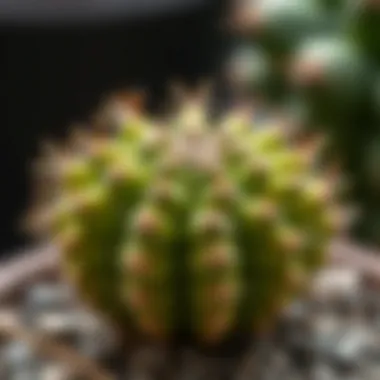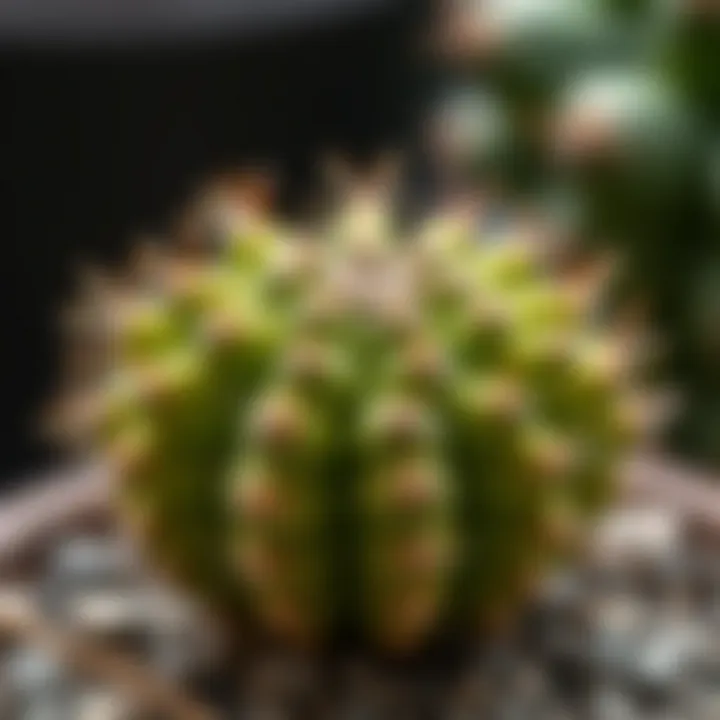Small Cactus Plant Types to Elevate Your Home Decor


Intro
When it comes to decorating your space, no one can deny the charm small cactus plants bring to the table. These little wonders don’t just sit pretty; they pack a punch in both style and convenience. From their distinctly sculptural shapes to their hardy nature, small cacti cater to a variety of tastes and lifestyles.
The variety is indeed staggering, with species ranging from the iconic Echinopsis to the more obscure Rebutia. Each has its characteristics that can enhance your home’s decor while demanding very little attention. Their minimalistic beauty serves as the perfect complement to various furniture styles, whether you lean towards modern, rustic, or even eclectic design. So, let’s take a closer look at how these charming plants can elevate your living spaces.
Furniture Styles and Trends
Exploring Popular Furniture Styles
The right furniture can change the whole vibe of a room. A small cactus can act as a splendid accent piece, merging seamlessly with numerous styles. Familiarity with these styles can help you make better choices when it comes to pairing your small cacti with other elements in your room.
- Mid-Century Modern: Characterized by clean lines and organic shapes, this style pairs wonderfully with the bold forms of small cacti. A sleek wooden side table with a classic Echinocactus in a decorative pot can transform an ordinary living room into a chic gathering space.
- Industrial: Think metal and exposed brick. Small succulents, including certain cacti, contrast beautifully with hard materials. A simple cactus in a distressed container can bring a touch of life into an otherwise edgy environment.
- Bohemian: This design celebrates mismatched decor with a natural flair. Imagine a low table surrounded by cushions, adorned with various cacti pots in assorted colors. Their playful shapes can contribute to the laid-back, yet artistically curated feel.
Understanding Current Design Trends
In keeping with the contemporary trends, small cacti not only provide aesthetic appeal but also reflect broader societal shifts towards sustainability and simplicity. As more individuals opt for houseplants, cactus varieties cement their place due to their low care demands.
“A small cactus not only occupies space; it also breathes life into it. These plants are a metaphor for resilience and adaptability in design – qualities that resonate with today’s homeowners.”
- Sustainable Living: With a focus on eco-friendly decor, many are gravitating towards plants that require minimal resources. Cacti can thrive in a few inches of soil and require little watering.
- Vertical Gardens: Tight living spaces are leading to innovative ideas. Small cacti can be arranged in wall-mounted planters, offering an artistic display while maximizing floor space.
- Personalized Spaces: People are increasingly looking to express themselves through their home decor. Unique cactus varieties can act as conversation starters while showcasing personal taste.
In essence, understanding furniture styles and current design trends can help one weave small cacti harmoniously into the fabric of home decor. Combining aesthetic with function, these plants offer dynamic versatility, making them worthy allies in modern interior design.
Practical Tips for Plant Selection
Choosing the right cactus for your home involves more than simply liking its appearance. Here are some key points to consider when selecting small cacti:
Factors to Consider When Choosing Cacti
- Size and Space: Not all cacti are created equal when it comes to growth. Make sure to select species that remain small or have a slow growth-rate to fit snugly in your chosen space.
- Light Requirements: Some varieties need direct sunlight, while others can thrive in lower-light environments. Know the lighting situation in your home.
- Maintenance Needs: While most cacti are low maintenance, certain species might require more attention. Researching care routines can save you from headaches down the road.
How to Measure and Optimize Space
- Visit the Space: Examine potential locations for your new cactus, taking into account the natural light levels and how much space you have to work with.
- Visualize Placement: Before committing, arrange furniture and plants temporarily to see how they mesh. Sometimes a small tweak can make a world of difference.
Caring for small cacti (or any plant, really) is often a back-and-forth dance between understanding their needs and providing the perfect home for them. By choosing the right varieties and placing them thoughtfully in your decor, the essence of cactus charm can flourish in your own home.
For more detailed information on caring for specific cactus varieties, visit Wikipedia or read up on articles from Britannica.
Prelims to Small Cacti
When it comes to sprucing up your living space, sometimes, less really is more. Small cacti bring a unique charm and character to home decor that larger plants simply can't replicate. One of the striking aspects of small cacti is their adaptability; be it in a well-lit room or a cozy nook, these hardy plants find their place with ease. This article aims to offer a thorough exploration of small cactus varieties, their care, and how they can transform interiors.
Defining Small Cacti
Small cacti, generally ranging from a few inches to around a foot tall, are part of the diverse family of cacti known for their ability to thrive in arid conditions. They often sport varied shapes—from globular bodies to tall and column-like forms—and may present a kaleidoscope of colors. Not just any plant can claim resilience while being an aesthetic delight, yet small cacti do just that, often flaunting impressive blooms when conditions are right.
These diminutive plants are native to environments with harsh climates, meaning they've honed their survival skills over time. They rely on their thick skins to prevent moisture loss, and many varieties feature spines or glochids for protection against herbivores. Differentiating between small cacti and their larger cousins is crucial for homeowners, as each variety demands specific care and attention. Recognizing what constitutes a small cactus can significantly shape the choices and arrangements one makes in their decor.
Benefits of Incorporating Cacti in Home Decor
Utilizing small cacti in interior design goes beyond mere aesthetics. Here are some benefits they bring to your living space:
- Low Maintenance: Cacti are ideal for busy households. They require minimal watering and can thrive in a variety of lighting conditions. For many, this makes them an ideal choice, as they fit seamlessly into a hectic lifestyle.
- Air Purification: Certain cacti are known to contribute to air purification. In a world where air quality is often compromised, having these plants around can improve the atmosphere in your home.
- Versatile Styling Options: From sleek modern styles to rustic themes, small cacti can adapt to numerous decor styles. They can be set in vibrant pots, placed on shelves, or grouped for an impact.
- Cost-Effective: Compared to other decorative elements, small cacti tend to be quite affordable. Many varieties are readily available, making it easy to experiment with different looks without breaking the bank.
- Creating Focal Points: A particularly striking cactus can draw the eye in a room, creating a conversation starter. Their unique charm often becomes a focal point in a well-thought-out decor scheme.
Incorporating small cacti into your decor not only enhances the visual appeal but also signals a connection with nature within your home.


As you continue reading, you will discover various small cactus varieties, their specific characteristics, and guidelines for care. In the exploration of these unique plants, the possibilities they offer for transforming a living space are boundless.
Common Varieties of Small Cactus Plants
When diving into the world of indoor plants, small cacti stand out for their diversity and charm. This section focuses on some of the most common varieties of small cacti that can enhance your home decor while maintaining low maintenance needs. Each type possesses unique characteristics that make them suitable for various settings, contributing to both aesthetics and air quality in your living space. Knowing these varieties helps in making informed choices tailored to both personal taste and environmental conditions.
Mammillaria
Characteristics
Mammillaria is often called the "pincushion cactus" due to its round, cushion-like shape. This variety is known for its small size, typically ranging from 2 to 12 inches, making it a perfect choice for shelves or desktops. One striking feature is its abundance of tiny spines, which can sometimes bloom into vibrant flowers, adding an extra splash of color. This characteristic of blooming is particularly beneficial, offering visual interest throughout its growing season.
Care Guidelines
Caring for Mammillaria is relatively straightforward, thanks to its adaptability. They thrive in well-draining soil and require infrequent watering, especially during the winter months. A key to their care is ensuring they receive bright, indirect light. This makes them a popular choice among those with varied lighting situations at home. However, overwatering poses a risk, leading to root rot, so it’s crucial to follow a careful watering routine.
Best Uses in Home Decor
Mammillaria fits seamlessly into many decor styles, from boho to modern. Their compact nature makes them versatile for various settings, including terrariums or as stand-alone pieces on a table. They also make delightful gifts, enhancing the recipient's space with minimal effort. Their low maintenance makes them particularly appealing for busy homeowners who still want to enjoy greenery.
Echinopsis
Characteristics
Echinopsis, known for its striking blooms that appear in vibrant pinks and yellows, is a show-stopper among small cacti. The geometric forms and smooth texture of this cactus create a natural appeal that can stand out in any room. The blooms typically only last a day, but they come in waves, ensuring ample opportunities to enjoy their beauty throughout the warmer months.
Care Guidelines
Caring for Echinopsis can be rewarding, as these resilient plants are quite forgiving. They prefer full sunlight and well-draining soil, making potting essential. A recommended watering tip is to let the soil dry completely between intervals, particularly during winter. This unique feature of needing deep but infrequent watering aligns well with busy lifestyles.
Best Uses in Home Decor
Echinopsis can be an exceptional focal point, easily drawing the eye whether placed alone on a coffee table or integrated into a larger arrangement. They can complement various design themes, from rustic to minimalist, thanks to their clean lines and bright flowers.
Gymnocalycium
Characteristics
Gymnocalycium, or "moon cactus," is distinctive for its ribbed surface and flattened appearance. Its varied colors, ranging from green to purple, provide exciting visual options for any plant lover. This variety stands out not just for its looks but also for its adaptability to indoor conditions.
Care Guidelines
With a penchant for indirect sunlight and moderate watering, Gymnocalycium thrives in standard cactus mixes. One interesting aspect is their resilience; these cacti can tolerate varying light conditions, which is a boon for those who may not have the brightest of homes. They can stay healthy and happy with minimal fuss, making them an accessible choice for beginners.
Best Uses in Home Decor
These cacti can be a delightful addition to mixed succulent arrangements, where their colors and shapes create a charming contrast. They also suit table centerpieces or can be grouped for a stunning display that catches attention without overwhelming space.
Parodia
Characteristics
Parodia is often characterized by its round shape and pronounced ribs adorned with tufts of spines. This recognizable form makes it not only appealing but also easy to care for. Some varieties even produce lovely yellow or pink flowers, captivating anyone who walks by. The robust nature of this cactus is a significant advantage as it can flourish in various environments.
Care Guidelines
Parodia prefers a bit of shade during the hottest parts of the day, making it a versatile option for homes that experience direct sunlight intermittently. Watering should be done sparingly, especially in cooler seasons. The ideal care features a simple rhythm, which allows for easy integration into any busy schedule.


Best Uses in Home Decor
Parodia can elevate any room's decor with its lush, green hue. Their ability to adapt to different styles means they can fit perfectly in modern layouts or even traditional setups. These plants can be a standout choice on a desk or as part of a small indoor garden.
Aloe Vera as a Small Cactus Alternative
Characteristics
While not a true cactus, Aloe Vera shares many traits that make it suitable for a similar role in home decor. Known for its fleshy, serrated leaves and potential health benefits, Aloe Vera offers a unique combination of aesthetics and utility. Its ability to thrive on neglect is appealing to many.
Care Guidelines
Aloe Vera requires low to moderate light and infrequent watering, mirroring the preferences of traditional cacti. The impressive aspect is its resilience; it can survive in less-than-ideal conditions. This hardy nature makes it a flexible option for various home environments.
Best Uses in Home Decor
Whether placed in a kitchen for easy access to its soothing gel or as a centerpiece on any table, Aloe Vera offers both beauty and practicality. Its sculptural form complements modern decor but can also fit well in rustic settings. Choosing Aloe Vera broadens the selection for plant lovers, making it an exciting alternative when diversifying plant collections.
Care and Maintenance of Small Cacti
Caring for small cacti is not just about giving them a sprinkle of water now and then. These plants, though hardy and capable of thriving in dry conditions, can still falter without the right attention to their needs. Proper care and maintenance play a vital role in how well your cacti flourish and fit within your home decor. Understanding what these plants require allows you to create an environment that is not just functional but also visually appealing.
Watering Techniques
One of the cardinal rules of cactus care is mastering how to water them correctly. Overwatering is a common pitfall—an enticing mistake that many novice gardeners make. Cacti have adapted to survive in arid conditions, hence they store moisture in their tissues. Generally speaking, the best practice is to water your cacti deeply but infrequently. A good rule of thumb is to wait until the top inch or so of soil feels dry to the touch before giving your cactus a drink. This could be once every two weeks in the summer and even less during the colder months.
- Signs of Overwatering: Droopy or yellowing pads, mushy texture.
- Signs of Underwatering: Wrinkling or shrinking appearance, dry tips.
By paying attention to these signs, you can gauge whether your watering routine is hitting the mark.
Soil Requirements
Cacti thrive in well-draining soil; a potting mix designed specifically for cacti and succulents is often your best bet. Regular potting soil tends to retain too much moisture, leading to root rot. Instead, look for mixes that contain sand, perlite, or pumice. Here’s a quick primer on the ideal soil composition:
- 50% inorganic materials: like perlite or coarse sand for drainage.
- 30% organic matter: ensuring some nutrients are available, which can come from compost.
- 20% moisture-retaining material: a balance to keep the plant hydrated without oversaturating.
When repotting, always use a pot with drainage holes to prevent water from sitting at the bottom of the container.
Light Exposure Needs
Cacti generally adore sunlight, and rightly so. These tough plants have evolved under the glaring sun, hence they'll flourish in bright, direct light. Ideally, aim for at least six hours of sunlight per day. Here are a few considerations when planning their light exposure:
- Positioning: A south-facing window often provides the optimal exposure.
- Artificial Light: If natural light is limited, consider grow lights to supplement sunlight, especially during overcast winters.
- Acclimatization: Be mindful when moving your cactus to a brighter area; sudden exposure could lead to sunburn. Gradually increase their light exposure over days.
A keen understanding of these care aspects will guide you in nurturing your small cacti effectively, ensuring they not only survive but also enhance the aesthetics and ambiance of your home. Be aware that while cacti are resilient, neglect can still take its toll, so a little attention goes a long way.
Placement Considerations for Small Cacti
When it comes to decorating with small cacti, placement is more than just finding a pretty spot. It can make or break the aesthetic you're aiming for and ensure the health of the plant. Understanding the nuances of placement will help you create a harmonious environment that highlights the unique qualities of your cacti while also ensuring they thrive.
Ideal Locations in the Home
Think of your home as a stage—each space needs its stars. Small cacti can shine in various locations, but they do have preferences. Key areas to consider include:
- Windowsills: Cacti love bright light, and a sunny windowsill can be like a luxury hotel for them. Just be cautious of the intense afternoon sun; sometimes, too much can cause those adorable spines to burn.
- Shelves and Bookcases: These can serve as surprising but effective displays. Cluster a few small cacti together on a shelf to create a vibrant patch. It creates depth and visual interest without overwhelming the space.
- Desks and Workspaces: Tiny cacti can not only beautify your workspace but also improve your mood. Having greenery around can boost productivity and creativity, while low maintenance means they won't interrupt your busy schedule.
- Dining Areas: Picture a trio of colorful cacti on the dining table. An arrangement like that can spark conversation and add a touch of desert charm to family meals or gatherings.
Creating a Cactus Display


Incorporating small cacti into your home decor is like painting a masterpiece. Every element should complement each other, creating a cohesive display. Here are some tips:
- Vary the Heights: Group cacti of different heights together. A short, squat cactus next to a tall one creates an appealing visual contrast.
- Choose Unique Pots: The right pot can elevate the overall look. Consider ceramic pots with interesting glazes or minimalist concrete for a more modern vibe. Even hanging planters can serve as conversation starters.
- Arrange with Purpose: Not every plant needs to be in a straight line. Try a staggered arrangement that draws the eye around the display. You can even mix in decorative stones or sand for added texture.
- Seasonal Adjustments: Change it up every now and then. Swap out one cactus with a seasonal faux flower or a different cactus for a fresh look without heavy lifting.
Safety Considerations
While cacti are generally low-maintenance, they do come with some safety considerations. It's important to think about the placement concerning pets and small children. Here are a few guidelines to keep in mind:
- Height Matters: Avoid placing cacti on low surfaces where pets or small children can easily access them. Higher shelves or desks are usually safer spots.
- Spines and Prickles: Be aware of the spines. They can be sharp and painful. Make sure that your display isn't close to high-traffic areas where someone might accidentally brush against them.
- Toxicity Check: Most cacti are non-toxic, but it’s always good to double-check if you have pets or children who might be curious. The ASPCA website can be a helpful resource for checking plant toxicity.
Remember: A well-placed cactus can be a stunning addition to your home, but safety should always come first.
By considering these placement tips for your small cacti, you can create an inviting space that is both beautiful and practical. Whether making subtle adjustments or designing vibrant displays, small cacti can add a unique touch to any room.
Potential Challenges of Keeping Cacti
Keeping small cacti at home can be an aesthetically pleasing decision, but it does come with some challenges. Understanding these challenges is vital for ensuring that your delightful green companions not only survive but thrive in your home environment.
One of the beauty of cacti is their ability to adapt to harsh conditions, but that doesn’t mean that they are wholly immune to issues. Minor nuisances like pests and diseases can crop up, and being prepared to tackle them can spell the difference between a lush plant and one that wilts away.
It is essential to be aware of these potential challenges so you can approach cactus care with both knowledge and confidence. This understanding will enhance your enjoyment of your plants while also ensuring their longevity.
Common Pests
When it comes to cacti, a few pesky invaders can become a thorn in your side. Here are some of the primary threats you might encounter:
- Mealybugs: These cottony critters can often be found nestled in the crevices of your cactus. Not only do they suck out precious nutrients, but their waxy coating can make them tough to get rid of.
- Spider Mites: Tiny and hard to see, spider mites thrive in dry spaces. If you notice tiny webs forming near your cactus, it might be time to reassess your plant’s health.
- Scale Insects: These can look like small bumps on the cactus surface. They can seriously harm your plant by sucking its juices, making it vital to act quickly once spotted.
To combat these unwanted guests, you might try using a mixture of water and mild soap, applying it directly to the affected areas. For heavier infestations, consider turning to insecticidal soap or neem oil—a natural and effective remedy.
Diseases Affecting Cacti
Diseases can be another hurdle in the cactus care journey, and they often stem from improper care rather than pests. Here are a few of the common illnesses one might face:
- Root Rot: Possibly the most common problem, overwatering can lead to this nasty condition. This occurs when the roots sit in waterlogged soil, causing them to decay. Symptoms include mushy stems and a general decline in plant vitality.
- Fungal Infections: These often manifest as dark spots on the cactus, potentially leading to decay. Problems arise typically when humidity levels are too high or airflow is restricted.
- Sunburn: This can seem counterintuitive, but cacti can suffer from sunburn if they are suddenly exposed to intense sunlight. This shows up as faded or discolored patches on the skin.
To keep your cacti healthy, the golden rule is to provide them with well-draining soil, adequate spacing for airflow, and a careful watering schedule. Equally important is to monitor your plants regularly, keeping an eye out for telltale signs of disease.
"An ounce of prevention is worth a pound of cure." Taking proactive steps can save you the heartache of watching your favorite cactus succumb to easily avoided issues.
Epilogue: The Role of Small Cacti in Modern Home Decor
Small cacti have carved a unique niche in home decor, serving as more than just mere decorations. These resilient plants bring an essence of the natural world into our homes, blending elegance with ease of care. The significance of small cacti extends beyond their aesthetic appeal; they provide a multifaceted charm that resonates with modern living.
Summarizing Benefits and Aesthetic Appeal
In every corner, a small cactus can breathe life into dull spaces. These plants often exhibit a variety of colors and shapes, ranging from the rounded Mammillaria to the tall Echinopsis. Their visual diversity contributes richly to design schemes and can complement both minimalist and eclectic decors. But it’s not just about looks.
- Low Maintenance: One of the biggest perks of small cacti is their low maintenance needs. For busy homeowners or those lacking a green thumb, these plants are forgiving and require minimal watering.
- Air Quality: Research indicates that some cacti improve indoor air quality by absorbing CO2 and releasing oxygen during the night, making your home feel fresher.
- Space Savers: Their compact size allows them to fit snugly on desks, shelves, or even window sills, making them suitable for any space.
When it comes to aesthetics, cacti add a touch of intrigue without overwhelming visual clutter. A small cactus on a coffee table or a windowsill adds character, drawing the eye in a subtle yet effective manner. They can be used as striking centerpieces or as supporting actors in larger arrangements.
"Plants serve as the silent companions that enhance our spaces with their quiet dedication to beauty and resilience."
Encouraging Responsible Plant Care
Despite their robustness, responsible care remains vital for sustaining these small wonders. Homeowners need to acknowledge their specific needs to ensure that their cacti not only survive but thrive. Here are a few key points to consider:
- Understanding Watering Needs: Overwatering is a common pitfall. Cacti thrive in dry conditions, so it’s best to err on the side of caution. If in doubt, it's better to wait a bit longer before giving them a drink.
- Choosing the Right Soil: A well-draining soil mix, typically designed for cacti and succulents, aids in preventing root rot. This simple choice can have a profound impact on the longevity of the plant.
- Adapting to Light Conditions: Even though cacti love light, they need to be acclimated slowly if brought from a dim environment to a brighter one.
With these simple considerations, any homeowner can enjoy the beauty of small cacti while ensuring their wellbeing. This blend of decorative excellence and conscientious care positions small cacti as a favored choice for those looking to enliven their spaces.
Ultimately, small cacti are more than just a trend; they symbolize a shift toward sustainable and effortless home designs that appeal to a wide audience. From interior designers seeking unique elements to homeowners wanting a dash of nature indoors, small cacti serve as the perfect bridge to achieving aesthetic goals in modern home decor.















